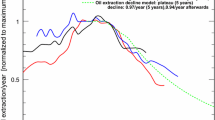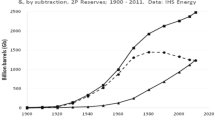Abstract
This paper examines three issues related to both the U.S. and world oil supply: (1) the nature of the long-term, postpeak production profile for the U.S. and, by inference, other regions (the Hubbert curve is used as a “strawman” model); (2) implications on U.S. energy security of using a modified Hubbert-type conceptual model of prepeak production, testing the adequacy of Latin America to be the primary source of U.S. oil imports; and (3) the cyclic behavior of oil prices. it shows that U.S. production will exhibit a more attenuated decline than that simulated by the Hubbert curve and not decline to zero. it asserts that U.S. production is better predicted by past reserves than past production, but that this argument does not apply to nations that keep a much larger proportion of reserves in the ground. Such nations could considerably expand production without any growth in reserves. The paper concedes that the potential total production for these nations could be examined with a Hubbert curve model linked to reserves, but with great uncertainty. Such an uncertain optimistic forecast predicts that the cumulative production of Latin America could far exceed that of the United States. Nevertheless, a statistical model of oil prices since 1870 implies that real wellhead oil prices in the United States are on a long-term upward path, underlying a much more “noisy” cyclical pattern estimated to include 22- and 27-year cycles. The statistical model predicts a severe oil shock within a few years (of 1998) but also predicts that through 2030, real oil prices will not reach 1981 levels again. The paper examines U.S. and world trends in seismic exploration, drilling locations and depths, drilling costs, oil/gas reserves, oil/gas use rates, and oil demand. After taking these factors into consideration, it concludes that the statistical model of oil prices cannot be disputed, despite its lack of basis in economic theory.
Similar content being viewed by others
References
American Petroleum Institute, 1997, Basic petroleum data book, v. XVII, n.1: Washington, D.C., Section II. Tables 1, 3, 4; Section III, Tables 9–13; Section IV, Tables 1, 4, 11; Section VI, Tables 1, 2; Section XI, Tables 3, 6; Section XIII, Tables 4, 7.
Beseda, J., 1997, Factors that influence the successful introduction of new technologies: unpublished manuscript, Strategic Planning Department, Toyota Motor Sales, U.S.A., Inc., presented at the U.S. Department of Energy Conference on Policies for Fostering Sustainable Transportation Technologies, Asilomar Conference Center, Pacific Grove, CA.
Carrying Capacity, Inc., 1986, Beyond oil.
Carson, M. M., 1997, Natural gas central to world’s future energy mix: Oil and Gas Journal, v. 95, no. 32, p. 37–47.
Coy, P., McWilliams, G., and Rossant, J. 1997, The new economics of oil: Business Week, p. 140–144.
Duncan, R. C., 1996, Mexico’s petroleum exports: Safe collateral for a $50 billion loan?: unpublished manuscript, Seattle, WA, Institute on Energy and Man.
Fagan, M. N., 1997, Resource depletion and technical change: Effects on U.S. crude oil finding costs from 1977 to 1994: The Energy Journal, v. 18, no. 4, p. 91–105.
Gordon, R. J., 1986, The American business cycle: Continuity and change: National Bureau of Economic Research Studies in Business Cycles, v. 25, p. 781–783. Chicago, IL, University of Chicago.
Gossling, B. F., 1976. Window on oil:in A survey of world petroleum resources: Financial Times, London, England.
Greene, D. L. and Leiby, P. L., 1993, The social costs to the U.S. of Monopolization of the world oil market, 1972–1991: Report ORNL-6744, Oak Ridge, TN, Oak Ridge National Laboratory. 61p.
Heavenrich, R. M., and Hellman, K. H., 1996, Light-duty automotive technology and fuel economy trends through 1996: Report EPA/AA/TDSG/96-01, Office of Mobile Sources, Ann Arbor, MI, U.S. Environmental Protection Agency, p. 3–5.
Hubbert, M. K., 1956, Nuclear energy and the fossil fuels: Drilling and production practice. Washington, D.C., American Petroleum Institute, p. 7–25.
International Energy Agency, 1997, Energy prices and taxes, second quarter 1997, Paris, France, 430p.
Leiby, P. and Rubin, J., 1998, Analyzing the transition to alternative fuel vehicles: Paper 981256, Washington, D.C., Transportation Research Board, National Research Council.
Lichtblau, J., 1996, The North American energy scene: International Association for Energy Economics Newsletter, p. 3, 4, and 7 fall.
Marchetti, C., 1987, The future of natural gas: Technological Forecasting and Social Change, v. 31, p. 155–171.
MacKenzie, J., 1996, Heading off the permanent oil crisis: Issues in Science and Technology, v. 12, p. 48–54.
McCormac, M. P., 1997, Ohio oil and gas activity, exploration on the upswing. Oil and Gas Journal, v. 95, no. 23, p. 67–70.
McDonald, S. L., 1971, Petroleum conservation in the United States: An economic analysis. Baltimore, MD, Johns Hopkins Press, p. 29–55.
North, F. K., 1985, Petroleum geology; Boston, MA, Allen and Unwin, 750p.
Oil and Gas Journal, 1996, Petroconsultants: Exploration poor in 1995, v. 94, no. 36, p. 33.
Roberts, R. B., 1997, Surge in gulf gas will impact Louisiana facilities: Oil and Gas Journal, v. 95, no. 33, p. 45–47.
Santini, D. J., 1995, Considerations in making projections to assess the best transportation technologies to meet Asilomar sustainability goals: unpublished manuscript, U.S. Department of Energy Conference, Pacific Grove, CA, Asilomar Conference Center.
Santini, D. J., 1992, Energy and the macroeconomy: Capital spending after an energy cost shock:in Energy Growth and the Environment: Advances in the Economics of Energy and Resources, Moroney, J. A., Ed., Greenwich, CN, JAI Press, p. 101–124.
Simon, J., 1996, The ultimate resource, v. II, Princeton, NY, Princeton University Press, 656p.
Speece, M. W. and MacLachlan, D. L., 1992, Forecasting fluid milk package type with a multigeneration new product diffusion model: IEEE Transactions on Engineering Management, IEEE Log No. 9107047, v. 39, no. 2, p. 169–175.
U.S. Bureau of the Census, 1975, Historical statistics of the United States, colonial times to 1970, Part 1, Washington, D.C., p. 197–201, 210–211, 593–594.
U.S. Department of Commerce, 1997, Survey of current business, Washington, D.C., Bureau of Economic Analysis, various issues.
U.S. Department of Energy, 1996a, Annual energy review, 1996: DOE/EIA-0384(96), U.S. Energy Information Administration, p. 41, 111–125, 137–139, 169, 187–189.
U.S. Department of Energy, 1996b, Transportation energy data book: Edition 16: ORNL-6898, Oak Ridge, TN, Oak Ridge National Laboratory, p. 1-5 to 1–14.
U.S. Department of Energy, 1997, Monthly energy review: Report DOE/EIA-0035(97/07), U.S. Energy Information Administration, p. 15, 111, 131.
Wamsted, D., 1995. Hodel: Another oil shock is on the horizon: The Energy Daily, v. 23, no. 58, p. 4.
Author information
Authors and Affiliations
Corresponding author
Rights and permissions
About this article
Cite this article
Santini, D.J. An assessment of oil supply and its implications for future prices. Nat Resour Res 7, 101–121 (1998). https://doi.org/10.1007/BF02767704
Received:
Accepted:
Issue Date:
DOI: https://doi.org/10.1007/BF02767704




